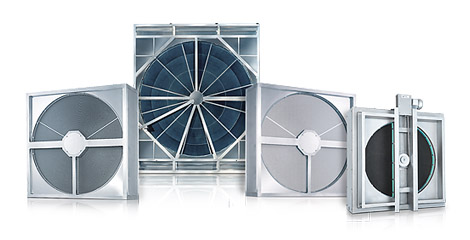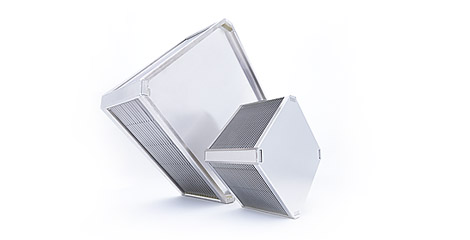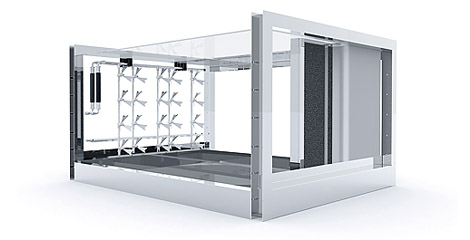Heat exchangers allow you to save significant energy and thus also money. In doing so they also make a real contribution towards climate change mitigation.

EU Commission: Immense CO2 Savings Potential
Worldwide, heat exchangers have an enormous potential to reduce CO2 emissions. According to a working document of the European Commission from 2012, some 100 million tonnes of CO2 are currently saved each year in the EU alone as a result of the use of heat recovery systems. And this applies only to non-residential buildings - i.e. offices, factories, hospitals, schools etc. The savings provided from residential buildings are therefore additional.
The study further indicates that with increased heat recovery, a further 50 million tonnes of CO2 can be spared per year by 2025 compared to the 2010 figure.
Case Study
Anyone who has an air handling unit in their building can effectively contribute to climate change mitigation. The extent can be illustrated with the example of a rotary heat exchanger just under three metres in diameter. Under prevailing climatic conditions in Western Europe, such rotors normally recover some 291,000 kilowatt-hours (kWh) of heat per year (see design calculation) in normal operation.
According to the report of the Enquete commission titled ‘Protection of the Earth’s AtmosPWTre’ conducted by the German Bundestag in 1994, CO2 emissions from using fossil fuels (lignite, anthracite, mineral oil and natural gas) can be estimated as follows:
CO2 Emissions by Energy Source
| Energy Source | CO2 emission (kg) per kilowatt-hour |
|---|---|
| Lignite | 0,400 kg CO2 / kWh |
| Anthracite | 0,330 kg CO2 / kWh |
| Mineral oil | 0,262 kg CO2 / kWh |
| Natural gas | 0,199 kg CO2 / kWh |
The CO2 savings potential for our rotary heat exchanger can be calculated based on these figures. Depending on which of these four energy sources are used, the following annual reductions in CO2 emissions are obtained (figures rounded):
CO2 Reduction using Rotary Heat Exchangers
| Energy Source | Reductions in tons per year |
|---|---|
| Lignite | 116,5 t/a |
| Anthracite | 96,1 t/a |
| Mineral oil | 76,3 t/a |
| Natural gas | 58,0 t/a |
Below we would like to demonstrate how these results are calculated. For this, however, we must first perform the technical design of the rotary heat exchanger and then calculate the viability.
Design of a Rotary Heat Exchanger
- Rotor type: RRS-P-C16-3000/3000-2840
- Foil thickness 0,08 mm
- Wave height 1,6 mm
- Standard volume ( 20 °C / 50 % / 1013 mbar )
- Volumes of supply and exhaust air approx. 30,000 m³/h
| Air intake | Supply air | Exhaust air |
|---|---|---|
| Temperature | -12 °C | 22 °C |
| Air volume | 26628 m³/h | 30192 m³/h |
| Rel. humidity | 90 % | 40 % |
| Abs. humidity | 1,20 g/kg | 6,56 g/kg |
| Air discharge | Supply air | Exhaust air |
|---|---|---|
| Temperature | 14,0 °C | -2,5 °C |
| Air volume | 29424 m³/h | 27527 m³/h |
| Rel. humidity | 43 % | 95 % |
| Abs. humidity | 4,21 g/kg | 2,91 g/kg |
From these figures we obtain heat exchange efficiencies for this rotor of 77% for the supply air and 71% for the exhaust air. The rotor also transfers 56% of the moisture of the supply air and 68% of that of the exhaust air.
| Exchange Capacities | |
|---|---|
| Sensible heat | 263 kW |
| Latent heat | 75 kW |
| Total heat | 338 kW |
| Humidity recovery | 108 kg/h |
Viability Calculation
To determine the potential for CO2 reduction we use the following viability calculation for winter operation. This is based on the specifications of the VDI 2067 guideline (Viability of building services equipment).
Winter operation is assumed to occur between November and April, i.e. the months in which buildings are heated in Climate Zone 3 countries (including Germany).
The design is valid for an average air pressure of 1013 millibars. The system operating hours are based on six days per week, daily operation from 06:00 to 18:00. Accordingly, the cumulative operating time for the whole year is 1862 hours. The following table lists heat recovery by month.
| Heat recovery, kWh | Sensible | Latent |
|---|---|---|
| January | 57.228,1 | 7.629,5 |
| February | 48.529,4 | 4.467,2 |
| March | 42.544,3 | 778,3 |
| April | 28.223,8 | 11,6 |
| May | ||
| June | ||
| July | ||
| August | ||
| September | ||
| October | ||
| November | 42.229,4 | 551,2 |
| Dezember | 54.283,6 | 4.877,2 |
| Total for Year | 273.038,6 | 18.314,9 |
By adding the amounts for sensible and latent heat recovery, we obtain a total energy recovery figure of 291,354 kilowatt-hours per year. Meanwhile, overall humidity recovery is 26,363 kg per year.
From these values we can finally determine the CO2 reduction potential from our first two tables.
It clearly emerges that: Anybody using heat exchangers in their air handling units can significantly reduce their heating/cooling costs, while also cutting emissions of the greenhouse gas carbon dioxide.








